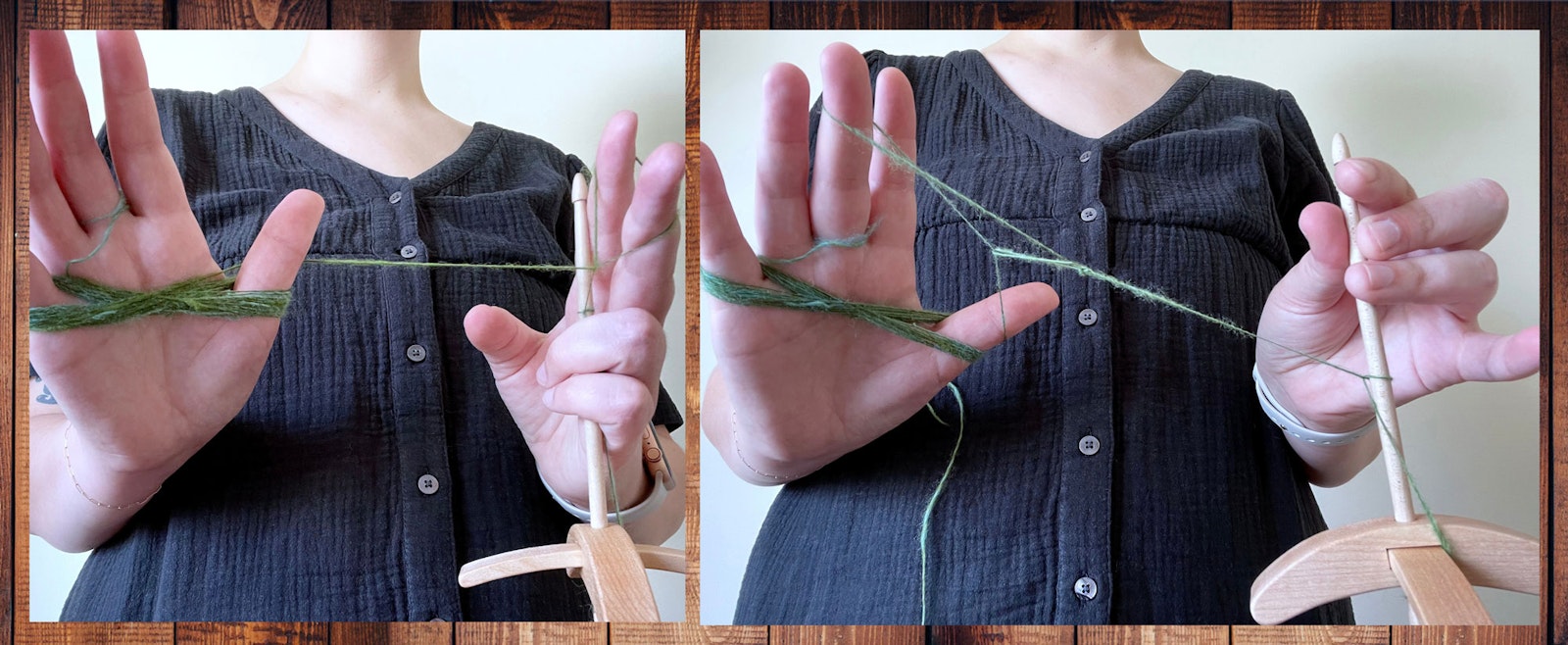The steps to the ply-on-the-fly method are surprisingly simple. First, build a temporary cop. Next, butterfly the yarn off the spindle and onto your hand. Finally, chain-ply the yarn as you transfer it back to the spindle and build the permanent cop.
In order to learn this technique, you should be familiar with spindle spinning, chain-plying, and butterflying singles onto your hand.
If you’re new to this and struggling, don’t give up: this technique definitely feels fiddly at first! Just keep practicing until the muscle memory kicks in, and don’t be discouraged if it takes a few rounds.
What Tools Do I Need to Ply on the Fly?
You’ll need a spindle and your spun singles. It can be done on Turkish spindles and those top- or bottom-whorl drop spindles that have a place to anchor the plying loop during the singles spinning stage, such as a spindle with a decorative gear-shaped whorl.
How To: Ply on the Fly
1. Butterfly Your Singles.
Spin up a temporary cop and break the singles from the fiber supply. Anchor the end of the singles by wrapping it around your middle finger a couple of times, and butterfly the singles onto the hand you want to use for plying.
2. Setup.
Anchor the singles to the spindle shaft with a half hitch. Use your spindle hand to make a second half hitch in the length of singles between the spindle and the butterfly (above left).
3. Create the First Plying Loop.
Hold the half hitch open wide. Using the middle finger of your butterfly hand, pull the singles through the half hitch. Drop the half hitch off your spindle hand (above right). This is your first plying loop.
4. Set Up for Plying.
Draw your butterfly hand farther away from the spindle, letting the yarn from the butterfly feed into the plying loop.
 Lengthening the plying loop
Lengthening the plying loop
5. Ply.
When your hands are several feet apart, give the spindle a spin to insert ply twist. (Remember to spin in the opposite direction from the one in which you spun your singles!)
6. Wind On and Reset.
When you are happy with the amount of ply twist, undo the half hitch on the spindle and wind your plied yarn on. Make a new plying loop by using your spindle hand to pull the singles through the previous plying loop. Drop the old plying loop and transfer the new one to your butterfly hand.
 Pulling the singles through the old plying loop. Next, drop the old loop and transfer the new one to your butterfly hand.
Pulling the singles through the old plying loop. Next, drop the old loop and transfer the new one to your butterfly hand.
7. Transitioning from Plying Back to Spinning.
When your butterfly has just enough unplied singles remaining to act as a leader for more unspun fiber, undo the half hitch on your spindle and wind the plied yarn on. Anchor the plying loop by placing it onto one of the wings of your spindle. Run your leader up the spindle shaft and continue spinning, building another temporary cop.
 Anchoring the plying loop
Anchoring the plying loop
8. Transitioning from Spinning to Plying Again.
Wind off your temporary cop to another butterfly. When you reach the old plying loop, take it off the spindle and create a new plying loop by pulling your fresh singles through it. Place the new plying loop on the middle finger of your butterfly hand and pick up plying from Step 4.
Shell Feda is a writer, multimedia artist, historian, and dreamer. They are particularly interested in late-nineteenth and early twentieth century history and the artistic and quotidian ephemera extant from that period. You can find Shell on social media @seabornecloud.

